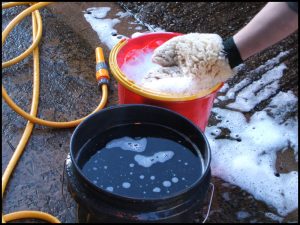When should I not polish
Written by: Vinnie van Rooij
There might be certain situation in which it is advised to not polish a certain surface. This can be due to damage, time limit, thin surface or other factors. Knowing when not to polish might be as important as knowing when to polish.
Contents
Reasons to not polish
Sometimes polishing is not the advised course of action when trying to improve the finish of a surface. In these situations it is likely that polish will either create further damage, not have any effect or result in a dangerous situation. An example of these situations are:
| The paint thickness is to little | Continuing polishing will cause you to remove the clear coat, or the colored coat (depending on type of paintwork). When this coat is removed, it is very costly to re-apply a new layer. |
| You are working in the burning sun | Polishing now will result in polish drying up too quickly. The polish will not get the desired results and the dried up residue might create marks and spots that are difficult to remove. Unless you have a special polish that can be used on a hot panel, it is advised to not polish. |
| You only have a rough compound | Polishing with only a rough compound will result in an unfinished surface. After the compound step you need to refine the result with a less aggressive polish. Not doing this can give holograms, marks or a satin-look instead of a glossy finish. |
| It is raining and you can’t work indoors | Polishing in the rain will not give the desired result. Not only is rainwater contaminated, which will be rubbed around by the polishing pad, it will also dilute the polishing agent so much that the lubrication is greater then the polishing-effect. The polish will hardly do anything anymore. |
| You are ill | Working with machines always exposes you to some risks. Either to the object you are working, yourself or both. None of these should be exposes to increased risk because the operator is not capable of handling the machine correctly. |
| The surface is satin or matte | Satin or matte surfaces do not respond will to being polished. Polishing is designed to increase the overall look and to add gloss. Polishing a satin or matte finish will increase the level of gloss and remove the matte or satin look. |
| You have not clayed the surface | Claying or at least using a chemical cleaning product is very important. This step removes unwanted particles from the surface, unwanted particles that behave in an unknown way. Polishing with these unwanted particles can result in an unwanted or unexpected result, which is not likely to improve the overall look of the surface. |
| The surface is very rough and damaged | polishing the surface now might result in damaging your polish pad, your machine and maybe expose you to more risk then needed. The damaged and rough surface might also prevent the polish from doing what it should do. The end result will most likely be not satisfactory and could potentially even create more damage then before polishing. |
| When you’ve just polished your car last week | Remember that you remove a little bit of paint every time you polish a surface. It can be compared with sanding, but very, very light sanding. Polishing too often will remove more paint then needed and could remove the paint in a shorter time then wanted. In a few years you wont have any paint left to work with. |
| When you are short in time | Polishing takes time. Every panel needs a certain amount of time until the polish agent it fully broken down. You can speed up the movement or the speed on the machine, but it will not make a huge difference. Not taking the proper time to break down the polish could result in unwanted imperfections like holograms, buffer trails and microswirls. |
| When working on a very delicate surface | Using a machine polish could be to fast and to rough. Using a handpolish pad will give you more control. But in some cases, even this could be too much for a certain type of finish. Always judge what you are working with before you decide the right approach. |
| When the surface is covered in chemicals | Chemicals on the surface might be picked up by the polishing pad and get sling around. Not only can it hit you, it is also spread out over a larger area then wanted. Make sure the surface is clean before you start to polish. |
 In the world of polishes there are several grades. Among them are the compounds. These are the rough polishes aimed at more cut and less refinement. A compound is often used in combination with a rotary, but can also be used with a DA polisher. ...
In the world of polishes there are several grades. Among them are the compounds. These are the rough polishes aimed at more cut and less refinement. A compound is often used in combination with a rotary, but can also be used with a DA polisher. ... The two-bucket method is possibly to most known and most used technique used by detailers and professionals, to wash a vehicle. It is one of 3 different types of washing a vehicle that are widely considered to be safe and correct ways of cleaning a surface....
The two-bucket method is possibly to most known and most used technique used by detailers and professionals, to wash a vehicle. It is one of 3 different types of washing a vehicle that are widely considered to be safe and correct ways of cleaning a surface.... Waterspots are mineral deposits left behind after a liquid (such as water) evaporated. During evaporation, only the water molecules will evaporate. The contamination in the water will be left behind. Minerals are a very common contamination in water....
Waterspots are mineral deposits left behind after a liquid (such as water) evaporated. During evaporation, only the water molecules will evaporate. The contamination in the water will be left behind. Minerals are a very common contamination in water.... When you are going to polish any surface, you are going to rub a product over the surface. While doing this you need a very controlled matter of particles to move over the surface to have any control over the result you'll achieve. Preparing the paintwork will help you to get as much control as possible....
When you are going to polish any surface, you are going to rub a product over the surface. While doing this you need a very controlled matter of particles to move over the surface to have any control over the result you'll achieve. Preparing the paintwork will help you to get as much control as possible.... The removal of wax is a necessary step before a protective product is (re-)applied or before polishing. Wax is a hard type of protective product that is made from a large portion of natural ingredients. It has a limited lifespan and needs to be removed after a certain period....
The removal of wax is a necessary step before a protective product is (re-)applied or before polishing. Wax is a hard type of protective product that is made from a large portion of natural ingredients. It has a limited lifespan and needs to be removed after a certain period.... Underbody cleaning is the act of cleaning the underside of the car to remove any dirt and restore the looks as when the car was new. This is a tedious and labor intensive job, but good cleaning products and tools can help to make it easier....
Underbody cleaning is the act of cleaning the underside of the car to remove any dirt and restore the looks as when the car was new. This is a tedious and labor intensive job, but good cleaning products and tools can help to make it easier....







Links to this article
There are no external links to this article. Yet.